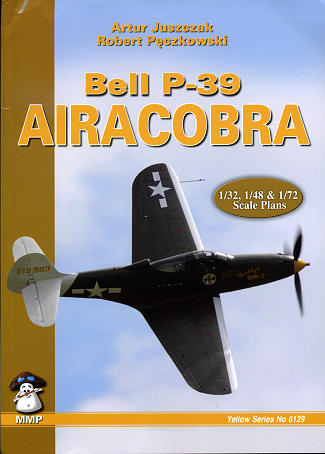 The P-39 was
an aircraft that was one of those 'what if' types that started out as an
outstanding interceptor design, but thanks to the lack of willingness to see it
built with the engine intended, turned into a somewhat mediocre performer.
The P-39 was
an aircraft that was one of those 'what if' types that started out as an
outstanding interceptor design, but thanks to the lack of willingness to see it
built with the engine intended, turned into a somewhat mediocre performer.
|
Author: |
Artur Juszczak & Robert Pęczkowski |
|
Publisher |
Mushroom Models Publications |
|
Price |
£13.99 MSRP |
|
Reviewer: |
|
| Notes: | #6129, 160 pages, B5 format, ISBN 978-83-61241-27-6 |
 The P-39 was
an aircraft that was one of those 'what if' types that started out as an
outstanding interceptor design, but thanks to the lack of willingness to see it
built with the engine intended, turned into a somewhat mediocre performer.
The P-39 was
an aircraft that was one of those 'what if' types that started out as an
outstanding interceptor design, but thanks to the lack of willingness to see it
built with the engine intended, turned into a somewhat mediocre performer.
Designed around a supercharged Allison engine, the prototype offered much promise in terms of speed. However, the USAAC decided it didn't want the two stage supercharged engine, opting for an unsupercharged engine. This alone was enough to cause performance to degrade quite a bit. Adding military equipment then took the plane out of contention as a fast interceptor. It was also rather unusual in having the engine behind the pilot, even though that did leave a lot of room in the nose for armament, including the large 37mm cannon.
With the war on the horizon, the aircraft was put into production. It was pretty much a pig above 15,000 feet, but below that was a somewhat capable performer. The aircraft was a total failure with the RAF who operated it in combat for only three days before removing it from the front line. The Soviets had much better luck as they used theirs at low level and appreciated the heavy punch of the nose mounted cannon. Even then, the number of modifications the Soviets made to the plane to have it meet standards was considerable.
The US had little choice but to use the Airacobra as there wasn't anything else available when they went to war. North Africa and the Southwest Pacific were the main areas of operation for US Airacobra units. Of course, the type was also used by training units back home, but the majority of Airacobras saw use with the Soviets, who flew them until the end of the war.
This new book in MMP's Yellow series takes a look at the design and development of the P-39 from the initial design through till the last one rolled off the production lines in 1944. The majority of P-39s were the P-39Q and most of those were, as you by now surmise, sent to the Soviets. Within the book's 160 pages is a complete rundown on the aircraft and its different variants, complete with descriptions of the differences between them. The history section covers the use of the aircraft both by the US and Allies.
A few of these planes are still flying and some are in museums around the world with the best original example being a Soviet P-39 in the Finnish AF Museum. It is in great shape considering it has never been restored and is one that is featured quite a bit in the color detail section. Other aircraft are also included in the details area and this includes period images and pages from the maintenance manuals to give even greater insight into this fighter. There are also a goodly number of the color profiles we have all come to expect from MMP books. As an added bonus, there are scale plans included in 1/72, 1/48 and 1/32 scale, the latter two provided as huge foldouts that provided additional detail drawings.
Overall, it is a most complete look at one of the world's more interesting fighters. A book that continues the excellence of MMP products and one that I can highly recommend to you.
July 2011
Review book courtesy of Mushroom Models Publications where you can order your copy. Australian readers can get theirs from Platypus Publications, and US readers from Casemate Publishing.
If you would like your product reviewed fairly and quickly, please contact me or see other details in the Note to Contributors.